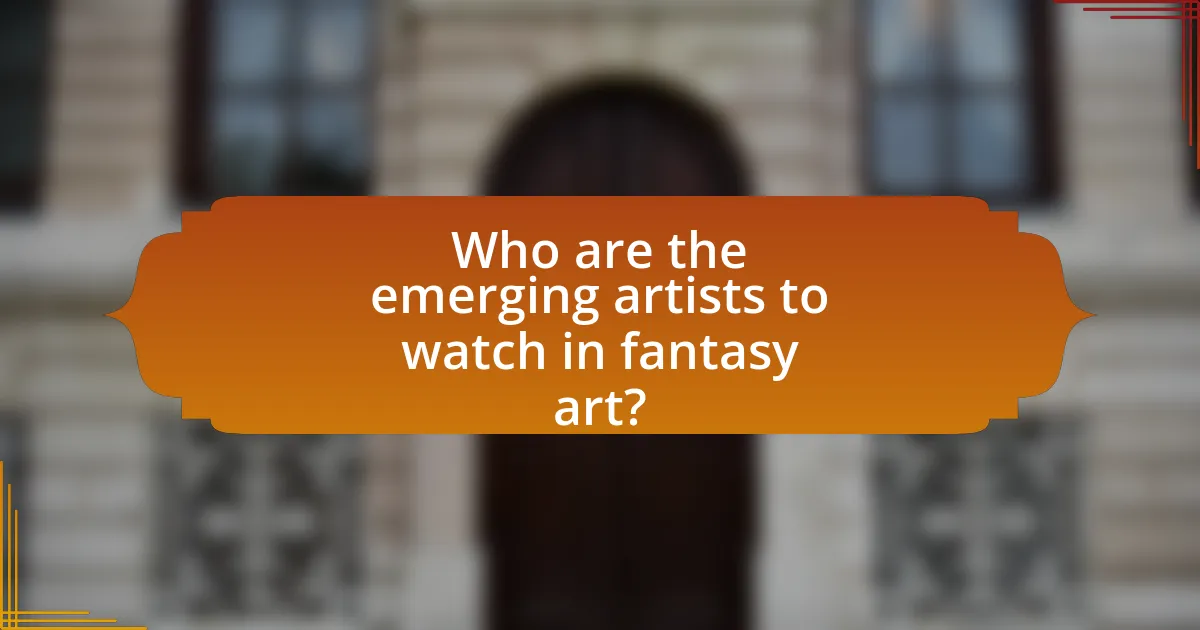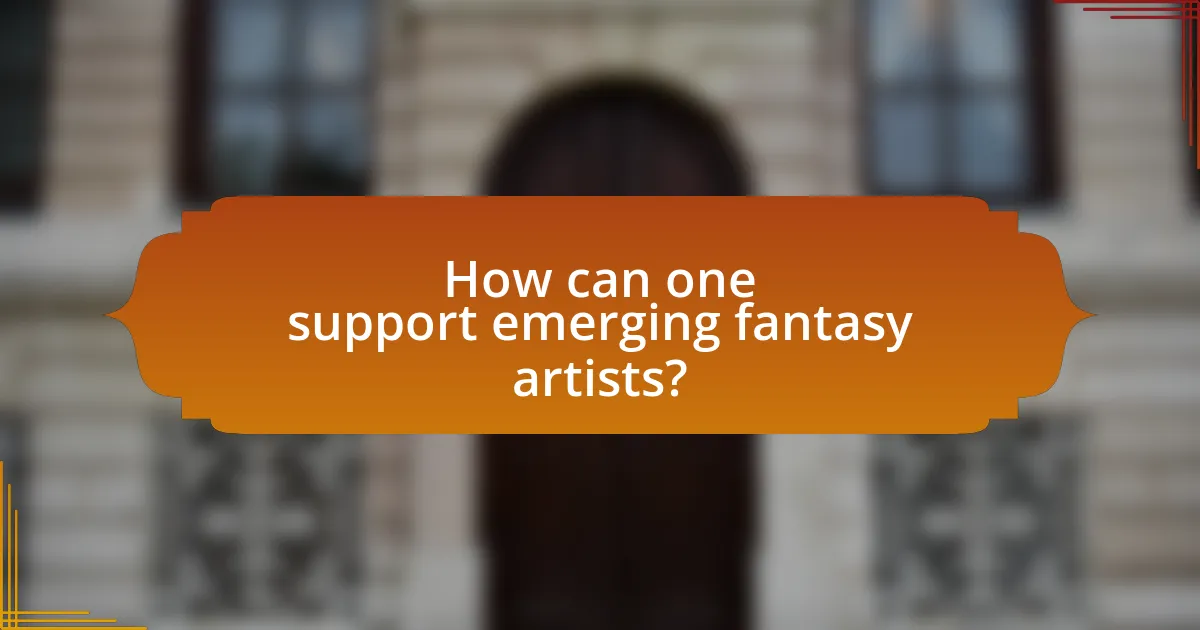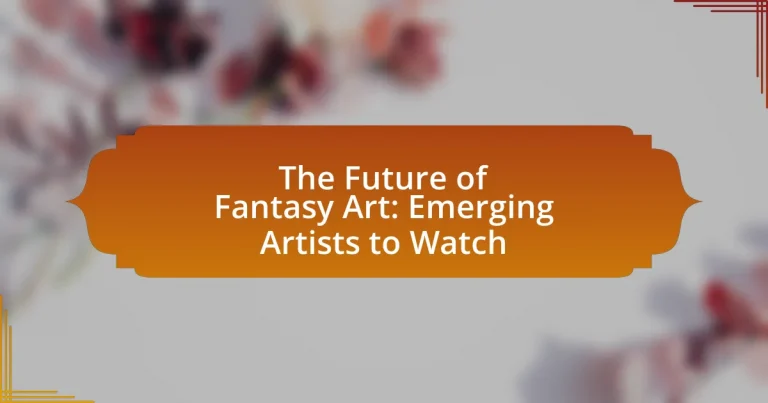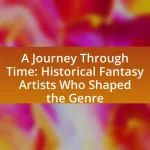The article focuses on the future of fantasy art, highlighting the significant role of emerging artists and the impact of technological advancements on the genre. It discusses how digital tools, artificial intelligence, and cultural shifts are reshaping artistic expression, allowing for greater diversity and innovation. Key emerging artists are identified, along with their unique contributions and techniques, while the importance of supporting these artists through community engagement and social media visibility is emphasized. The article also outlines best practices for collectors and fans to foster the growth of new talent in the fantasy art scene.

What is the Future of Fantasy Art?
The future of fantasy art is characterized by the integration of advanced technology, particularly digital tools and artificial intelligence, which are reshaping artistic creation and accessibility. Emerging artists are increasingly utilizing software like Procreate and Adobe Creative Suite, alongside AI-driven platforms, to enhance their creative processes and produce innovative works. This technological evolution allows for greater experimentation and collaboration, as artists can share their work globally through social media and online galleries, expanding their reach and influence. Additionally, the rise of virtual reality and augmented reality is creating immersive experiences that redefine how audiences engage with fantasy art, suggesting a dynamic and evolving landscape for the genre.
How is the landscape of fantasy art evolving?
The landscape of fantasy art is evolving through the integration of digital technology and diverse cultural influences. Artists are increasingly utilizing digital tools, such as graphic tablets and software like Procreate and Adobe Photoshop, which allow for greater experimentation and accessibility. This shift has led to a rise in self-taught artists and online platforms, enabling a broader range of voices and styles to emerge. For instance, the popularity of social media platforms like Instagram and ArtStation has facilitated the discovery of new talent, allowing artists from various backgrounds to showcase their work globally. Additionally, the incorporation of themes from different cultures and social issues is becoming more prevalent, reflecting a more inclusive and varied artistic expression within the fantasy genre.
What technological advancements are influencing fantasy art?
Technological advancements such as digital painting software, 3D modeling tools, and artificial intelligence are significantly influencing fantasy art. Digital painting software like Adobe Photoshop and Procreate allows artists to create intricate designs with ease, while 3D modeling tools such as Blender and ZBrush enable the visualization of complex characters and environments. Additionally, artificial intelligence technologies, including generative adversarial networks (GANs), assist artists in generating unique concepts and styles, enhancing creativity and efficiency. These advancements have transformed the way artists conceptualize and produce fantasy art, making it more accessible and diverse.
How are cultural shifts impacting the themes in fantasy art?
Cultural shifts are significantly impacting the themes in fantasy art by introducing diverse narratives and perspectives that reflect contemporary societal values. For instance, the rise of inclusivity and representation in media has led artists to explore themes of identity, gender, and race within fantastical contexts, moving away from traditional Eurocentric narratives. This shift is evidenced by the increasing popularity of works that feature protagonists from various cultural backgrounds, as seen in the art of creators like Kadir Nelson and Yuko Shimizu, who incorporate elements from their heritage into their fantasy illustrations. Additionally, the growing awareness of environmental issues has prompted artists to depict themes of nature and sustainability, aligning fantasy art with current global concerns. These changes illustrate how cultural dynamics shape the visual language and storytelling in fantasy art, making it more relevant to today’s audiences.
Why is it important to recognize emerging artists in fantasy art?
Recognizing emerging artists in fantasy art is crucial for fostering innovation and diversity within the genre. Emerging artists often bring fresh perspectives and unique styles that challenge traditional norms, thereby enriching the fantasy art landscape. For instance, a study by the National Endowment for the Arts highlights that exposure to diverse artistic voices can lead to greater creativity and cultural understanding. By supporting these artists, the art community not only nurtures new talent but also ensures the evolution of fantasy art continues to reflect a wide array of experiences and ideas.
What role do emerging artists play in the evolution of fantasy art?
Emerging artists play a crucial role in the evolution of fantasy art by introducing innovative styles, diverse perspectives, and fresh narratives. Their unique approaches often challenge traditional conventions, leading to the expansion of the genre. For instance, artists like Loish and Artgerm have gained recognition for blending digital techniques with personal storytelling, which has influenced both established and upcoming creators. This infusion of new ideas not only revitalizes the fantasy art landscape but also reflects contemporary cultural themes, making the genre more relevant to modern audiences.
How can emerging artists challenge traditional norms in fantasy art?
Emerging artists can challenge traditional norms in fantasy art by incorporating diverse cultural influences and innovative techniques. By blending elements from various artistic traditions and utilizing modern digital tools, these artists create unique interpretations that defy conventional aesthetics. For instance, artists like Yuko Shimizu and Kadir Nelson have successfully integrated their cultural backgrounds into their fantasy works, showcasing narratives that reflect a broader spectrum of human experience. This approach not only expands the visual language of fantasy art but also invites audiences to engage with new perspectives, thereby reshaping the genre’s boundaries.

Who are the emerging artists to watch in fantasy art?
Emerging artists to watch in fantasy art include Kieran Yanner, known for his vibrant illustrations and contributions to Magic: The Gathering; and Kaja Foglio, recognized for her work in the Girl Genius comic series, which blends steampunk and fantasy elements. Additionally, artists like Kelsey Montague, who creates interactive street art with fantasy themes, and Greg Rutkowski, celebrated for his digital paintings that often feature mythical creatures, are gaining significant attention. Their unique styles and innovative approaches are reshaping the landscape of fantasy art, making them noteworthy figures in the genre.
What criteria define an emerging artist in the fantasy art scene?
An emerging artist in the fantasy art scene is defined by their innovative style, growing recognition, and active engagement within the community. These artists typically demonstrate a unique artistic voice that sets them apart from established creators, often incorporating fresh concepts or techniques that resonate with contemporary audiences. Recognition can be measured through participation in exhibitions, online platforms, or social media engagement, where their work garners attention and feedback. Additionally, emerging artists often contribute to collaborative projects or community events, showcasing their commitment to the genre and building a network that supports their growth.
How do social media platforms influence the visibility of these artists?
Social media platforms significantly enhance the visibility of emerging fantasy artists by providing them with direct access to a global audience. These platforms, such as Instagram, Twitter, and TikTok, allow artists to showcase their work, engage with fans, and connect with other creators, which can lead to increased recognition and opportunities. For instance, a study by the Pew Research Center found that 72% of adults use at least one social media site, indicating a vast potential audience for artists. Additionally, algorithms on these platforms often promote content based on engagement, meaning that popular posts can reach even wider audiences, further amplifying an artist’s visibility.
What are the common themes and styles among these emerging artists?
Emerging artists in fantasy art commonly explore themes of identity, nature, and mythology, often blending traditional and digital techniques. These artists frequently utilize vibrant color palettes and intricate details to create immersive worlds that reflect personal narratives and cultural influences. For instance, many incorporate elements of folklore and fantasy creatures, drawing inspiration from diverse mythologies, which enhances the depth of their work. Additionally, a trend towards environmental consciousness is evident, as artists depict the relationship between humanity and nature, emphasizing sustainability and ecological themes. This combination of thematic exploration and stylistic innovation positions these artists as significant contributors to the evolving landscape of fantasy art.
Which emerging artists are making a significant impact currently?
Emerging artists making a significant impact currently include Kieran Yanner, known for his vibrant fantasy illustrations, and Kaja Foglio, recognized for her unique blend of steampunk and fantasy elements. Kieran Yanner’s work has gained attention through publications like “Magic: The Gathering,” showcasing his ability to create immersive worlds. Kaja Foglio’s contributions to the “Girl Genius” webcomic have garnered a dedicated following, highlighting her storytelling prowess alongside her artistic talent. Both artists exemplify the innovative spirit of contemporary fantasy art, influencing the genre’s evolution.
What unique techniques do these artists employ in their work?
Emerging artists in fantasy art employ unique techniques such as digital painting, 3D modeling, and mixed media to create their work. Digital painting allows for intricate detail and vibrant colors, enabling artists to manipulate images easily and experiment with styles. 3D modeling provides depth and realism, allowing artists to visualize complex scenes and characters in a three-dimensional space. Mixed media combines traditional and digital methods, enhancing texture and visual interest. These techniques reflect the evolving landscape of fantasy art, where technology and creativity intersect to produce innovative and captivating pieces.
How are these artists engaging with their audience?
These artists are engaging with their audience through interactive social media platforms, live-streaming events, and community-driven projects. By utilizing platforms like Instagram and Twitch, they share their creative processes in real-time, allowing fans to witness the evolution of their artwork and participate in discussions. Additionally, many artists host virtual workshops and Q&A sessions, fostering a sense of community and direct interaction. This engagement strategy not only builds a loyal following but also encourages collaboration and feedback, enhancing the overall artistic experience for both the creators and their audience.

How can one support emerging fantasy artists?
One can support emerging fantasy artists by purchasing their artwork, promoting their work on social media, and attending their exhibitions or events. Purchasing artwork directly provides financial support, allowing artists to continue creating. Promoting their work on platforms like Instagram or Twitter increases visibility and can lead to new opportunities. Attending exhibitions or events fosters community engagement and provides artists with networking opportunities, which are crucial for their growth and exposure in the industry.
What platforms are best for discovering and supporting these artists?
The best platforms for discovering and supporting emerging fantasy artists include Instagram, ArtStation, and Patreon. Instagram allows artists to showcase their work to a broad audience, with over 1 billion active users, making it a vital space for visibility. ArtStation serves as a dedicated platform for artists to display portfolios, connect with industry professionals, and participate in community challenges, which enhances their exposure. Patreon enables fans to directly support artists through subscriptions, providing them with a sustainable income while offering exclusive content to supporters. These platforms collectively foster a supportive environment for emerging artists in the fantasy art genre.
How can art communities foster the growth of emerging artists?
Art communities can foster the growth of emerging artists by providing networking opportunities, mentorship programs, and platforms for showcasing their work. These communities often organize events such as exhibitions, workshops, and critiques that allow emerging artists to connect with established professionals and gain valuable feedback. For instance, organizations like the Artist Trust in Washington state offer grants and professional development resources specifically aimed at supporting emerging artists. Additionally, online platforms such as DeviantArt and Behance enable artists to share their portfolios, receive constructive criticism, and engage with a broader audience, which can lead to increased visibility and career opportunities.
What role do art shows and exhibitions play in promoting new talent?
Art shows and exhibitions play a crucial role in promoting new talent by providing a platform for emerging artists to showcase their work to a broader audience. These events facilitate networking opportunities, allowing artists to connect with industry professionals, collectors, and potential patrons, which can lead to future collaborations and sales. According to a study by the National Endowment for the Arts, participation in exhibitions significantly increases an artist’s visibility and can enhance their career trajectory, as 70% of artists reported that exhibiting their work led to new opportunities. Thus, art shows and exhibitions are essential for the growth and recognition of new talent in the art world.
What are some best practices for engaging with emerging fantasy artists?
To effectively engage with emerging fantasy artists, it is essential to provide constructive feedback and support their creative endeavors. Constructive feedback helps artists refine their skills and develop their unique styles, while support can include sharing their work on social media or collaborating on projects. Engaging in online communities, such as forums or social media groups dedicated to fantasy art, fosters connections and encourages dialogue. Additionally, attending art shows or conventions allows for direct interaction, which can inspire and motivate emerging artists. These practices not only enhance the visibility of new talent but also contribute to a vibrant artistic community.
How can collectors and fans effectively support these artists?
Collectors and fans can effectively support emerging fantasy artists by purchasing their artwork directly, which provides financial stability and recognition. Direct purchases from artists, whether through online platforms or at conventions, ensure that a larger portion of the sale goes to the creator, fostering their growth and sustainability in the industry. Additionally, sharing their work on social media platforms increases visibility and can attract new audiences, as demonstrated by the rise of artists who gained significant followings through platforms like Instagram and Twitter. Engaging with artists through comments and feedback also builds a supportive community, encouraging them to continue creating.
What are the benefits of following and sharing their work?
Following and sharing the work of emerging fantasy artists provides several benefits, including the promotion of creativity and innovation within the art community. By following these artists, individuals gain access to fresh perspectives and unique styles that can inspire their own artistic endeavors. Sharing their work helps to amplify their visibility, potentially leading to greater opportunities for the artists, such as collaborations, exhibitions, and sales. This collective support fosters a vibrant artistic ecosystem, encouraging the growth of new talent and diverse expressions in the fantasy art genre.


